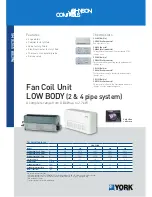
25
VENT INSTALLATION CONSIDERATIONS
This water heater can be vented using room air for intake
combustion air, or direct vented so that all intake air for combustion
comes from the outside through a sealed pipe.
This water heater may be installed in 4 separate orientations
depending on the requirements of the building and the water
heater. The installer must decide which method is most appropriate
for each installation. These orientations are:
1.
Vertical Termination - vertical vent termination through
unenclosed or enclosed areas with roof penetration, refer to
Vertical Vent Terminal Installation on Page 31.
2.
Through-the-Wall Termination - horizontal vent termination
directly through an outside wall, see “Figure 13: VENT
3.
Horizontal Direct Vent - using Through-the-Wall Termination to
exhaust flue products and piping to bring combustion air to the
water heater from the outside. See “Figure: 15” on Page 28.
4.
Vertical Direct Vent - using a vertical vent termination to
exhaust flue products and piping to bring combustion air to
the water heater from outside, see “Figure: 21” & “Figure: 22”
on Page 32.
In cold climates any water vapor remaining in the flue gases will
condense into a cloud of vapor at the point where the vent system
exits the building. Special consideration is recommended, before
locating the vent termination near walkways, windows and building
entrances.
Direct venting into dead spaces such as alleys, atriums, and
inside corners can cause recirculation of flue gases. Recirculation
of flue gases will cause sooting, and icing of the combustion air
intake during severe cold weather. To prevent the recirculation
of flue gases, maintain as much distance as possible between
the combustion air intake and the exhaust vent terminal refer to
“Figure: 16” and “Figure: 17” on Page 29 & Page 30 respectively.
U.S. INSTALLATIONS
NOTE:
This unit can be vented with PVC pipe materials (DWV
ASTM-D2665 or CSA B181.2; Schedule 40, 80, 120 ASTM-D1785
or CSA B137.3; or SDR Series ASTM-D2241 or CSA B137.3),
CPVC pipe materials (CPVC41 ASTM-D2846 or CSA B137.6;
Schedule 40, 80 ASTM-F441 or CSA B137.6; or SDR Series
ASTM-F442), ABS pipe materials (Schedule 40 DWV ASTM-D2661
or CSA B181.1) and Centrotherm ECO Systems and DuraVent
Polypropylene listed vent systems. The fittings, other than the
TERMINATION
should be equivalent to PVC-DWV fittings meeting
ASTM D-2665 (Use CPVC fittings, ASTM F-438 for CPVC pipe and
ABS fittings, ASTM D-2661/3311 for ABS pipe). If CPVC or ABS
pipe and fittings are used, then proper cement must be used for all
joints, including joining the pipe to Termination (PVC Material). If
Polypropylene pipe and fittings are used, the metal joint connector
rings, available from the Polypropylene vent manufacturer must be
used to stiffen the joints of pipes.
PVC Materials should use ASTM D-2564 Grade Cement; CPVC
Materials should use ASTM F-493 Grade Cement and ABS
Materials should use ASTM D-2235 Grade Cement.
CANADIAN INSTALLATIONS
Installation of this water heater must comply with the current edition
CAN/CSA B149.1 - Natural Gas and Propane Installation Code which
requires the vent system components be certified to ULC S636.
This water heater has been design certified to be vented with
PVC/CPVC pipe and Polypropylene pipe certified and marked as
complying with ULC S636.
If the water heater is being installed as a replacement for an
existing power vented heater in pre-existing venting, a thorough
inspection of existing venting system must be performed prior
to any installation work. Verify that correct material as detailed
above has been used, and that the minimum or maximum vent
lengths and terminal location as detailed in this manual have been
met. Carefully inspect the entire venting system for any signs of
cracks or fractures, particularly at joints between elbows and other
fittings and straight runs of vent pipe. Check system for signs of
sagging or other stresses in joints as a result of misalignment of
any components in the system. If any of these conditions are found,
they must be corrected in accordance with the venting instructions
in this manual before completing installation and putting the water
heater into service.
NOTE:
For water heaters in locations with high ambient
temperatures above 100°F (38°C) it is recommended that CPVC or
Polypropylene or ABS pipe and fittings be used.
All vent (exhaust) pipes must be pitched a minimum of a 1/4” per
foot back to the water heater to allow drainage of condensation.
Never operate the water heater unless it is vented to the outdoors.
The instructions in this section of the manual must be followed
to avoid choked combustion or recirculation of flue gases. Such
conditions cause sooting of the combustion chamber, burners and
flue tubes and creates a risk of asphyxiation.
For direct vent application where combustion air might be supplied
from extremely cold ambient through fresh air intake piping
system, it is recommended that a backflow preventer be installed
at the intake vent terminal close to the blower before proceeding
with installation of the rest of the fresh air intake piping. Call the
technical support phone number listed on the back cover of this
manual for more information.
VENTING INSTALLATION
















































